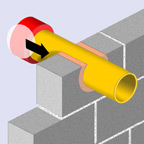
Evaluation of innovative structural bearings
A manufacturer of bearings for civil engineering structures has introduced innovations in the sliding material, which improve the mechanical performance and durability of the product, but also remove the possibility to obtain the CE mark according to harmonized standard EN 1337-7. ITeC has offered an alternative solution through the European Technical Assessments, that requires to draw a specific testing protocol that must be compatible with the nature of the bearing materials and the evaluation criteria that EOTA has already specified in previous EADs.

Evaluation of structural reinforcement systems
Procedure for evaluating a system to repair reinforced concrete pillars and walls with structural capacity deficits, covering them with a thin layer of a high strength mortar with added metal fibers. A program of tests and calculation has been defined on the basis of Spanish and European regulations, and it will allow a future certification of the solution.

Evaluation of concrete additions obtained from the incineration of municipal solid waste
Design of a protocol for assessing the validity of a type II addition manufactured with treated ashes from municipal waste incinerators. It allows to quantify the mechanical, chemical and durability performance that can be expected from different combinations of this addition with CEM II and CEM IV cements that produce concrete mixes as per the EN-206 standard, and also mortars and grouts.

Regulatory situation of structural joints for concrete
The European standard EN 1090-1 on steel and aluminium structural components affects a large number of products, which has required the European Commission to clarify what conditions must be met for a product to be eligible for CE marking through this standard. The systems for structural joints are among the products that have been left in a slightly ambiguous regulatory situation. A manufacturer has asked ITeC to confirm which specific procedure this type of stress-transmitting joints must follow in order to be CE marked.

Fire resistance of expansion joints with stress transmission
A manufacturer offers a method for adding expansion joints in concrete slabs that are capable to transmit shear forces. In order to get it certified, it is required to demonstrate its fire resistance, so it must undergo a test according to UNE-EN 1365-2. But the standard does not contemplate the case where there is a joint in the test specimen, and ITeC has advised on how to define a specimen that is faithful to the real conditions of application and that will be fully admitted by the certifying bodies.

Evaluation of a foundation kit for light structures
Procedure for assessing a building technique for foundations for temporary or permanent light structures, as per the requirements of mechanical resistance and stability (BR 1) and safety in case of fire (BR 2) of Regulation (EU) No. 305/2011. The calculation of the mechanical behavior has taken into account the physical properties of soil, the depth of the foundation and the dimensions of the steel bars that are driven into the ground.

Regulatory framework of reinforcements for masonry bed joints
Identification of the standards that affect CE marking of the structural reinforcement products designed to be embedded in the horizontal mortar joints in load-bearing brick walls.

Assessment of fireproofing solutions for pipe penetrations
The fire resistance of walls and floor slabs is compromised in those points where pipes go through, so if it is critical to guarantee their integrity in case of fire, specific sealing elements such as intumescent collars must be used. The evaluation has required to determine on a case-by-case basis how much fire resistance time can be expected according to the type of collar, material and geometry of the pipe, and components and geometry of the wall or floor.

Evaluation of connectors for expansion joints in concrete structures
The assessment carried out by ITeC is the first ETA issued in Europe for this type of products within the scope of ETAG 030 'Dowels for structural joints'. It includes a method of dimensioning of connectors that ensures the transmission of shear stresses, paying attention to the design of the rebars surrounding the rod housings, and to the fire resistance of these critical points where the slabs suffer a discontinuity to allow expansion.

Evaluation of fire protection systems for structures
Development of the EU-level regulatory and functional requirements for evaluating different products and technologies to protect different types of structures (steel, concrete, compound or other materials) against fire using intumescent paints, mortars or boards. It is part of ITeC’s contribution to the European working group that develops the ETAG 018 guideline that is the reference document for evaluating these protection systems.



